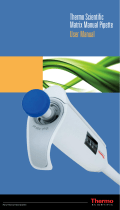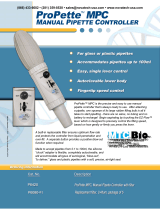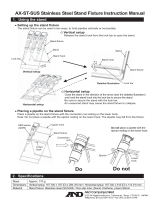Page is loading ...

EN ENGLISH
User's Guide
PIPETMAN
®
ultra

2
PIPETMAN
®
ultra
1 INTRODUCTION
Congratulations on acquiring your new Pipetman
Ultra. It is a quality product from Gilson, which is
fully ISO8655 compliant, CE labeled (conforms to the
EC directives on in vitro diagnostic medical devices,
electromagnetic compatibility and safety). Enjoy the
following features.
Easy of use:
- Continuously-adjustable parallax-free electronic
display for easy volume setting,
Contents Page
1 INTRODUCTION 2
2 PARTS CHECK LIST 3
3 DESCRIPTION 4
4 SWITCHING ON 5
5 VOLUME INDICATOR LCD WINDOW 6
6 SETTING THE VOLUME 7
7 GILSON DIAMOND
®
TIPS 8
8 PIPETTING 10
9 PERSONALIZING YOUR PIPETTE 12
10 GLP FEATURES 14
11 TROUBLESHOOTING 15
12 MAINTENANCE 16
13 CLEANING AND DECONTAMINATION 26
14 LEAK TEST 28
15 USER ADJUSTMENT 29
16 SPECIFICATIONS 31
17 EQUIPMENT DISPOSAL 33
18 SPARE PARTS 34
APPENDIX RESET PROCEDURE 40
EC DECLARATION OF CONFORMITY 41

3
- Flashing indicators if volume set is out of range,
- Ergonomic design, maximum comfort for left or
right-hand users,
- Low tip-ejection force, light, balanced,
- Simple to maintain and adjust,
- Other GLP features.
Performance:
- Accurate and precise,
- Unbeatable results with Gilson Diamond Tips,
- Easy and secure tip loading from Gilson Tipacks,
- New auto-shut off system to maximize battery
life.
Applications:
- For any type of lab.
- Suitable for most liquids.
- Molecular studies, kinetic studies, DNA sequenc-
ing, enzyme-assays, and the measurement
and transfer of general aqueous solutions.
2 PARTS CHECK LIST
Just take a moment to verify that the following items
are present:
- Pipetman Ultra pipette,
- Certificate of conformity (including bar-code
sticker),
- User's Guide,
- Identity tags (5 diff erent colors),
- Safety bag,
- Recalibration (user adjustment) tool,
-
Tip-holder reassembly tool (Multichannel models
only),
- Lubricant tube (except for U2 and U10),
- Tip ejector extension (U2 and U10 only),
- Sample pack of tips.

4
PIPETMAN
®
ultra
3 DESCRIPTION
See below the legends to the opposite fi gure.
Push-button for switching on, setting the volume,
aspirating, and dispensing (button is color coded
with the volume range printed on the top).
Ergonomic stabilizer, to make the pipette more
comfortable to use, and to reduce fatigue.
Thumbwheel, to set and lock the volume.
Tip-ejector button, can be positioned for left or
right-handed operation.
a
Liquid Crystal Display (LCD) window for volume-
setting and status indicators.
b
Identity-tag window (see “GLP features”).
Connecting nut.
Tip-ejector stroke adjustment-wheel.
Tip-holders – removable for cleaning and servicing
.
Ejector: removable to access piston assemblies
and tip-holders.
Table - Operating Ranges
Model Reference Range Color code
U2 F21021 0.2 - 2 μL Orange
U10 F21022 1 - 10 μL Red
U20 F21023 2 - 20 μL Pale yellow
U100 F21024 20 - 100 μL Peach
U200 F21025 20 - 200 μL Yellow
U1000 F21026 200 - 1000 μL Blue
U5000 F21027 1 - 5 mL Purple
U10ml F21028 1 - 10 mL Clear blue
8x20 F21040 1 μL to 20 μL Pale yellow
12x20 F21041 1 μL to 20 μL Pale yellow
8x300 F21042 20 μL to 300 μL Green
12x300 F21043 20 μL to 300 μL Green
Pipetman Ultra specifi cations are only valid with the use
of Diamond tips.

5
Body
(Handle)
Volumetric
module
(lower part)
4 SWITCHING ON
Press the push-button to the second stop (purge)
to switch on the pipette. The information displayed
in the LCD window depends on the status of the
pipette and the volume currently set (see below).
When the volume is
locked
, Pipetman Ultra turns itself
off after 3 min of inactivity – just press the push-button to
the second stop (or unlock the thumbwheel) to reactivate
the pipette.

6
PIPETMAN
®
ultra
If the volume is unlocked for 15 sec, you will see
LOCKED/UNLOCKED fl ashing
during 10 min to warn you to
lock the thumbwheel.
If you have not locked the pipette, Pipetman
Ultra turns itself off after 10 min of inactivity.
Just lock the thumbwheel (volume setting) and
“Init 1” will appear.
Follow the instruc-
tions of Appendix to
reset the pipette.
5 VOLUME INDICATOR LCD WINDOW
What you normally see...
Volume setting
Units (μL or mL)
Volume status (locked or
unlocked)
What may appear...
Calibration status: “RECAL” this means that your
pipette has been readjusted.
Battery status: failing – “LOW BATT” here, or failed
– “BATT” in place of volume setting.
Electronic counters:
Holding down the push button to the second stop
for 5 seconds, successively displays counters at the
right-hand side of an otherwise blank screen. Are
displayed in order:
a) Cycle counter since the last volume setting
– the counter indicates the
number of pipetting cycles
(max. 199); for example 126
cycles.
b) Cycle counter since the pipette was made – the
counter indicates the number of pipetting cycles
|
0
0
LOW BAT
UNLOCKED
RECAL
μl

7
(maximum 999,999); for
example 285,396 cycles.
c) Readjustment counter since
the pipette was made – the
counter indicates the num-
ber of times the pipette has
been readjusted (maximum
99); for example 03 readjustment operations.
Refer to “Troubleshooting” for possible error messages.
6 SETTING THE VOLUME
You must perform the following steps:
Switch on: press the push-button to the second
stop. LCD shows the volume currently set.
Unlock: push the thumbwheel upwards. LCD
shows UNLOCKED (also visible on the thumb-
wheel).
Set the volume: rotate the thumbwheel or the
push-button (clockwise to decrease the volume,
counterclockwise to increase):
- when decreasing the volume, reach the
required setting slowly, making sure not to
overshoot the mark.
- when increasing the volume, pass the required
value by 1/3 of a turn, then decrease the vol-
ume slowly, making sure not to overshoot the
mark.
Lock the volume: push the thumbwheel down-
wards. LCD shows LOCKED.
03
RECAL
To unlock
To lock
Thumbwheel
LCD
|
0
0
UNLOCKED
μl

8
PIPETMAN
®
ultra
To reduce battery consumption, lock the volume
before storing Pipetman Ultra.
• You are strongly advised to lock the volume, to avoid ac-
cidentally changing the setting when pipetting.
• The units indicator fl ashes, if you set a volume below 90 % of
the minimum recommended; you can dispense an aspirated
volume below the minimum recommended. However, in
this case, the specifi cations cannot be guaranteed.
• The volume indicator fl ashes, if you try to set a volume
above the maximum permitted; you must not try to pipette
a volume that is greater than the maximum permitted.
7 GILSON DIAMOND TIPS
Gilson Diamond Tips are made to the highest specifi ca-
tions; strict quality control is maintained throughout
the manufacturing process.
Diamond Tips are used to calibrate
Pipetman Ultra, therefore for opti-
mum performance, you are strongly
advised to use Gilson’s Diamond
Tips with your pipette. Diamond
Tips have the Gilson logo engraved
on their collar, ensuring that you
have a genuine Gilson product.
To ensure accuracy and precision, Gilson’s Quality
Assurance System focuses on the following critical
parameters.
• Diamond Tips are made from pure polypropylene
(virgin, metal-free, to avoid the possibility of con-
tamination). They are available sterilized and with
fi lters.
• They may be autoclaved at 121 °C for 20 minutes
at 0.1 MPa.
• Gilson's sterilized Diamond Tips are certifi ed free of
detectable RNases, DNases, DNA, RNA, pyrogens,
and trace metal.
• Optimized shape (revised collar for optimum seal-
ing, thin walls, and fi ne point), making them easier

9
to mount, more fl exible, with no vortexing, and
improved precision.
• Mold and cavity references are marked on the col-
lar, ensuring the traceability for quality assurance
purposes, batch numbers appear on all packages
(bags and boxes).
• They form an air-tight seal with the tip-holder,
preventing the leaks that cause poor accuracy and
a lack of precision.
Tipack - Rocky Rack
Diamond Tips are best
fi tted from a Rocky Rack
(patented). Rocky Rack is
the dome-shaped part of
the pack that contains the
tips. Rocky Rack makes it
easy to securely fi t the tips
to a multichannel pipette,
ensuring an airtight seal
on all channels without the
need to use undue pres-
sure or to touch the tips.
Table - Tips to use for best results
Pipette Diamond Tips Volume (Range)
U2 D10, DL10 0.2 μL to 2 μL
U10 D10, DL10 1 μL to 10 μL
U20 D200 2 μL to 20 μL
8X20 DL10, D200 1 μL to 20 μL
12X20 DL10, D200 1 μL to 20 μL
U100 D200 20 μL to 100 μL
U200 D200 20 μL to 200 μL
8X300 D200, D300 20 μL to 300 μL
12X300 D200, D300 20 μL to 300 μL
U1000 D1000 200 μL to 1 mL
U5000 D5000 1 mL to 5 mL
U10 ml D10 ml 1 mL to 10 mL

10
PIPETMAN
®
ultra
8 PIPETTING
Operating procedure
1) Optionally, for Ultra Multichannel set the head to
any position that is comfortable and practicable
for your application. To do this, simply turn the
head to the desired position.
2) Fit new Diamond Tips.
You must fi t tips to your pipette before aspirating and
dispensing any liquid. Plastic tips are for a single ap-
plication – they must not be cleaned for reuse.
3) Pre-rinse the tips.
Some liquids (e.g. protein-containing solutions
and organic solvents) can leave a fi lm of liquid on
the inside the wall of the tip; pre-rinse the tip to
minimize any errors that may be related to this
phenomenon. Pre-rinsing consists of aspirating
the fi rst volume of liquid and then dispensing it
back into the same vessels (or to waste). Subse-
quent volumes that you pipette will have levels
of accuracy and precision within specifi cations.
4) Aspirate.
Press the push-
button to the
first stop (this
corresponds to
the set volume of
liquid).
Hold the pipette
vertically (± 20°)
and immerse the
tip in the liquid (see
table for immersion
depth).
Release the push-button slowly and smoothly
(to top position) to aspirate the set volume of
liquid.
Wait one second then withdraw the pipette-tip
from the liquid.
Model Immersion Wait Time
Depth (mm) (seconds)
U2 1 1
U10 1 1
U20 2-3 1
8x20, 12x20 2-3 1
U100 2-4 1
U200 2-4 1
8x300, 12x300 2-3 1
U1000 2-4 2-3
U5000 3-6 4-5
U10 ml 5-7 4-5
Table - Immersion Depth
and Wait Time

11
You may wipe any droplets away from the outside
of the tip using a medical wipe, however if you
do so take care to avoid touching the tip’s
orifi ce.
5) Dispense.
Place the ends of the tips against the inside
walls of the recipient vessels (at an angle of 10°
to 40°).
Press the push-button slowly and smoothly to
the fi rst stop.
Wait for at least a second, then press the push-but-
ton to the second stop to expel any residual liquid
from the tips. Keep the push-button pressed fully
down and (while removing the pipette) draw the
tips along the inside surface of the vessel.
Release the push-button, smoothly.
6) Eject the tips by pressing fi rmly on the tip ejector
button.
The tip ejector stroke can be set to allow for diff erent
types of tip, where (for example) the length of the collar
is diff erent (refer to “Personalizing Your Pipette”).
General Guidelines for Good Pipetting
1) Make sure that you operate the push-button
slowly and smoothly.
2) When aspirating, keep the tips at a constant
depth below the surface of the liquid (refer to
the table “Immersion Depth and Wait Time”).
3) Change the tips before aspirating a diff erent
liquid, sample, or reagent.
4) Change the tips if droplets remain at the end of
the tip from the previous pipetting operation.
Top First Stop Second Stop

12
PIPETMAN
®
ultra
5) The tips should be pre-rinsed with the liquid to
be pipetted.
6) Liquid should never enter the tip-holders; to
prevent this:
- press and release the push-button slowly and
smoothly,
- never turn the pipette upside down,
- never lay the pipette on its side when there is
liquid in the tip.
The use of a Gilson “Carrousel™”, “Trio™” or “Single™”
holder is recommended to store pipettes in the
upright position.
7) When pipetting liquids with temperatures dif-
ferent to the ambient temperature, pre-rinse the
tips several times before use.
8) For volatile solvents you should saturate the
air-cushion of your pipette by aspirating and
dispensing the solvent repeatedly before aspirat-
ing the sample.
9) Avoid pipetting acids or other corrosive liquids
that emit vapors. Extensive contact with corrosive
fumes may corrode the pistons or damage the
seal and tip-holders.
10)
The pipette can be used between +4 °C and
+40 °C, but the specifi cations may vary (see
Chapter 16 for controlled conditions of use).
11) Do not pipette liquids having temperatures
above 70 °C or below 4 °C.
Extreme temperatures can aff ect accuracy and
precision.
9 PERSONALIZING YOUR PIPETTE
Comfort of Tip-ejector
Before you start to pipette you can adjust the tip-
ejector button according to your preferences.
1) Position the tip-ejector button. Simply rotate

13
the tip ejector button to the most comfortable
position: left, right, or middle.
2) Set the stroke by rotating the adjustment wheel
until you fi nd the position where it is most easy to
activate the tip ejector. You may want to reset the
stroke after fi tting a diff erent type or size of tip.
Tip-ejector Extension for Use with Ultra U2 and U10
In order to eject D10 tips, tip ejector
extensions are supplied with U2 and
U10 pipettes.
The tip-ejector extension which is made
of PVDF (polyvinylidene Fluoride), is
autoclavable.
To fi t a tip-ejector extension:
- hold the pipette with the LCD window uppermost,
- hold the extension with the slot
uppermost,
- slide the extension over the tip-
holder,
- push the extension fi rmly onto the
end of the tip-ejector until it clicks
into place (see opposite).
To remove a tip-ejector extension (see
opposite):
- hold the pipette in one hand and
grip the extension with the other,
- gently twist the extension (either
direction) and pull it away from
the
pipette.
Slot
Tip-ejector Button
(set for right handed user)
Stroke Adjustment Wheel

14
PIPETMAN
®
ultra
Head Position for Multichannel only
You can adjust the position of the head to suit your
needs. Simply rotate the head relative to the body of
the pipette. Normally, you would set the head either
parallel to or at 90° to the body, but you can choose
any position between the two. Remember to check
that the connecting nut is tight after adjusting the
head position.
Personal Label - Name Tag
You can identify your pipette with a name tag:
1) Pry out the window by inserting a small screw-
driver in the access slot.
2) Position the name tag next to the LCD.
3) Clip the window back into place.
Plastic window
Access slot
(insert screwdriver here)
Stick Name Tag here (or bar code sticker)
10 GLP FEATURES
There are as follows:
• Locked volume.
• Serial Number: engraved on body of the pipette
and is encoded in the bar-code.
• Bar Code: on the box and with the certifi cate (can
be transferred).
• Name Tag (Application or User).
• Cycle counters:
- from last volume setting (to count the number
of cycles in the current “run”),
- from manufacture (to count the number of
cycles for servicing purposes).

15
Symptom Possible Cause Refer to page
Pipette is leaking sample Damaged tip-holder(s) 17-19
(one or more channels) Worn O-ring. 17-19
Pipette won’t aspirate Worn O-ring. 17-19
Damaged tip-holder(s). 17-19
Connecting nut is loose. 18
Damaged or corroded piston. 17-19
Improper repair or assembly. 16-19
Noisy operation Piston(s) needs lubricating. 20
Pipette is inaccurate Improper repair or assembly. 16-19
Pipette is out of adjustment. 29-31
Connecting nut is loose. 18
Pipette is not precise
Connecting nut is loose. 18
Volume setting not locked. 7
Incorrect operator technique. 9-12
Damaged or corroded piston(s). 17-19
Damaged tip-holder(s). 17-19
Worn O-ring. 17-19
Tips fall off Low quality tips. 8-9
or Damaged tip-holder(s). 17-19
don't fi t Adjustment of tip-ejector stroke 12-13
No LCD display Pipette is not swiched on. 5
Battery has failed. 24-25
• Flashing display when volume set is out of
specifi cations.
• Cycle counter when pipette has been readjusted
(see Chapter 15).
• Channel number embossed on the head of each
pipette for Multichannel.
• Useful volume-range is printed on the push-button
and the cover-ejector.
11 TROUBLESHOOTING
Before returning any pipette, ensure that it
is completely free of chemical, biological, or
radioactive contamination. Use the safety
bag provided by Gilson.
You may be able to identify and to correct the problem
by reference to the following table.

16
PIPETMAN
®
ultra
12 MAINTENANCE
You may perform the following:
-
clean or autoclave the parts specifi ed under
“Cleaning and Decontamination”,
-
replace the parts specifi ed under “Spare Parts”,
- lubricate the pistons,
- change the battery,
- calibrate and readjust the pipette.
쎱
Operation for Single-channel models
Tip-holder and Tip-ejector
These parts must be changed, if they are accidentally
damaged or attacked chemically. You should also re-
move these parts for cleaning or decontamination
purposes.
Changing the Tip-ejector
1)
Keep the tip-
ejector
button
depressed and
grip the top of the
tip-ejector with
the other hand.
Symptom Possible Cause Refer to page
“INIT1” on display The pipette has not been locked after 6
10 minutes of inactivity.
Volume has not been set to the correct 29-31
calibration volume when the calibration
tool was plugged in.
“INIT 2” on display Setting problems. 29-31
“INIT 3” on display Battery was changed. 24-25
Other Error Message
If the following occur, contact your Gilson distributor.
Message Cause
ERR4 Electronic problems (microchip).
Tip-ejector

17
2)
Gently rotate the
tip-ejector counter-
clockwise and sep-
arate its connector
from the activating
rod.
3) Pull the tip-ejector away from the body of the
pipette.
4) Clean or autoclave the tip-ejector and refi t it (or a
new one) by reversing the procedure.
Changing the Tip-holder (lower part)
After removing the tip-ejector, you may remove
the lower part of the tip-holder, which is more likely
to become contaminated or damaged than the upper
part. Removal of the lower part is shown below; for the
upper part see “Removing the Piston” (special precau-
tions are necessary).
1) Gently rotate the
lower part of the tip-
holder counterclock-
wise to unscrew it
from the upper part.
2) Separate the parts and remove the O-ring (see
“Changing the O-ring”).
3) Clean and if required autoclave the lower part of
the tip-holder.
4) If required lubricate
the piston (see “How to
Lubricate the Piston”)
and fi t a new O-ring.
5) Screw the two parts together, making sure that the
two parts are fully tightened, by hand.
6) Refi t the tip-ejector.
Changing the seal and/or O-ring (see Chapter 18)
The O-ring is contained by the two halves
of the tip-holder; it must not be autoclaved,
if worn or damaged in any way, it must
be replaced.
Tip-holder (upper)
Tip-holder (lower)
Piston
O-ring

18
PIPETMAN
®
ultra
To access the O-ring, remove the tip-ejector and un-
screw the lower part of the tip-holder - if the O-ring is
not immediately visible on the piston, set the pipette
to its maximum volume, then press the push-button
to the second stop. You should now be able to remove
the O-ring from the piston. Sometimes, the O-ring may
be found in the recess at the top-end of the lower part
of the tip-holder.
If required lubricate the piston (see “How to Lubricate
the Piston”) then fi t a new O-ring by sliding it onto the
piston. Reassemble the pipette.
The dimensions of the O-ring vary according to the
pipette model - refer to “Spare Parts” for details.
Servicing the Piston
You may remove the piston-assembly to clean, lubri-
cate, or change the piston.
The specifi cations of the pipette must be checked
after changing the piston (see Chapter 16).
Removing the Piston
1) Set the volume to zero and lock the pipette. Do not
unlock the pipette or try to reset the volume while
changing the piston assembly.
2) Remove the tip-ejector and (optionally) the lower
part of the tip-holder.
If you remove the lower part, take care to remove the
O-ring as described in “Changing the O-ring”.
3) Unscrew the connecting-
nut (turn by hand, counter-
clockwise).
4)
Pull on the spring guide to remove the piston
assembly
from the body of the pipette - separate
the parts (see below).
For U5000 and U10 ml, the connecting nut is com-
bined with the upper part of the tip-holder (see “Spare
Parts”).
5) Clean and autoclave (if required) the piston and
holder, together with any other parts that may

19
need to be treated in the same way (see “Cleaning
and Decontamination”).
6) Lubricate the piston, see next page.
7 ) Reassemble the piston, spring and spring guide;
then carefully insert the assembly into the body
of the pipette. The spring guide should hold the
piston assembly inside the body of the pipette.
Take care to position the small-diameter
end of the spring as shown (innermost),
and that the fl anged end of the spring
guide is outermost.
8) Reassemble the upper part of the tip-holder and
the connecting nut, then refi t to the body of the
pipette by rotating the connecting nut clockwise
until it is fi nger tight. Fit the O-ring (or for U2 and
U10, the seal) and reassemble the lower part of the
tip-holder. Refi t the tip ejector.
The seals for U2 and U10 are fragile and can only be
used once. So, after unscrewing the lower part of the
tip-holder you must fi t a new seal.
Spring (Tapered)Piston holder Piston Spring Guide
Tip-holder
(Upper)
Tip-holder
(Lower)
Connecting Nut
Spring guide-
fl anged end
Spring-small diameter end
Connecting Nut
Spring guide-
fl anged end

20
PIPETMAN
®
ultra
How to Lubricate the Piston (except U2 and U10)
Use only Gilson lubricant (ref: F2070902, as sup-
plied). Squeeze a small quantity from the tube onto
a clean, nonabrasive cloth. Use the cloth to transfer
the lubricant to the piston. Ensure that the piston is
evenly lubricated, and that you wipe away any excess
- remember only a fi ne fi lm of lubricant is required (over
the entire piston).
쎱
Operation for Multichannel models
The two main parts of the pipette are the body
(handle) and the volumetric module (lower part).
The body contains electrical and mechanical compo-
nents that must not be in contact with liquids.
The volumetric module of the pipette contains the tip-
holders
and the piston assemblies, components that
could be in contact with liquids. To service these items
you must fi rst remove the plastic ejector-cover, which
also may be cleaned or replaced.
Removing the Volumetric module
The connecting nut joins the head to the body. Unless
you need to separate the volumetric module from the
body, you should not fully undo the connecting nut. If
the connecting nut becomes loose in normal use, turn
it clockwise until fully tight. This action may be neces-
sary after adjusting the position of the head. When
you need to separate the two halves of the pipette,
proceed as follows.
1)
Set the volume to zero and lock the pipette.
2) Keep the tip-ejector button depressed and grip
the ejector-clip.
3)
Unlock the ejector-
clip and separate it
from the activat-
ing rod.
4) Unscrew the connecting nut.
5) Press push-button to extract the head.
/






